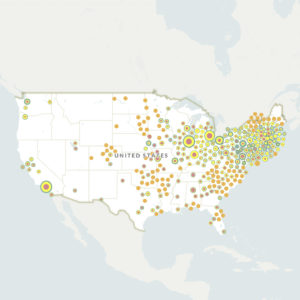This article was originally published by Cincinnati Children’s and shared nationally through PR Newswire on September 24, 2024. Read the original article.

An old government policy that determined who was eligible to receive government-supported home refinancing based on the race, ethnicity, and immigration status of neighborhood residents known as “redlining” was banned decades ago. Even so, children growing up now in many of the affected neighborhoods are still paying a price in the form of higher risk of developing asthma.
For years, studies have shown that asthma’s harm is felt most acutely by Black and Hispanic children and in low-income neighborhoods.
Now, a study analyzing data from Boston, Baltimore, New York, Nashville, St. Louis, Detroit, and Madison documents how today’s ongoing neighborhood-level disparities in asthma outcomes remain linked to housing policies dating back to the 1930s. Findings appear in the American Journal of Respiratory and Critical Care Medicine.
“We found that children who lived in neighborhoods that had been redlined were at increased risk for asthma and that much of this increased risk was related to higher rates of poverty and lower household income,” said co-lead author Patrick Ryan, PhD, an expert at Cincinnati Children’s who studies how environmental exposures affect pediatric respiratory health and brain development.
“The health disparities that exist today didn’t just happen – there are root causes,” Ryan says. “In this study, we show that a systemic racist policy implemented in the 1930s is directly related to asthma disparities today in part because it prevented those neighborhoods from developing through the years with healthy environments.”
The study was conducted by members of the Children’s Respiratory and Environmental Workgroup (CREW) consortium. Founded in 2016 with funds from the National Institutes of Health’s Environment and Child Health Outcomes (ECHO) program, CREW was established to integrate more than a dozen birth cohort studies that have tracked groups of children to study the origins of asthma.

Separately, these groups can lack enough size and diversity. Combined, they can help accelerate understanding of how asthma is affected by interactions between genetics, lifestyle, and environmental exposures, said James Gern, MD, professor and vice chair of research, Division of Allergy, Immunology, and Rheumatology, and principal investigator for the CREW consortium.
“This study applied new technologies linking addresses to exposures to demonstrate just how important housing and economic factors are in determining the risk for developing childhood asthma,” Gern said. “Improving living conditions and addressing structural racism are likely to markedly reduce childhood asthma and have many other health benefits.”
Additional co-authors from the Department of Pediatrics include Daniel Jackson, MD, professor, Sima Ramratnam, MD, MPH, associate professor, and Christine Seroogy, MD, professor, all from the Division of Allergy, Immunology, and Rheumatology.
In the headlines
News outlets from across Wisconsin featured Gern in stories about this research, including Wisconsin Public Radio, WIFR, WQOW, WXOW, WISC-TV, and Wisconsin State Journal.